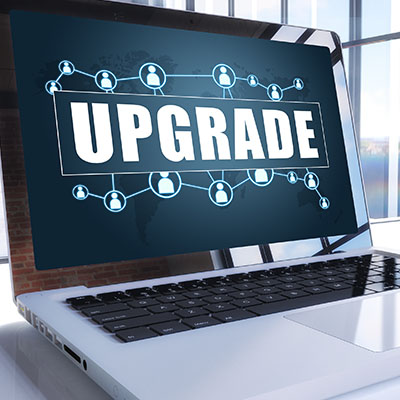- I.T.

I.T
Cyber
Communications
Tip of the Week: Bringing Legacy Systems to Modernity
July 6th, 2022

There are numerous reasons to update your business’ technology—particularly if this technology is crucial to your business’ processes. However, many businesses still rely on legacy systems. This makes it a challenging prospect to update them appropriately, unless you know what you’re doing. This week, we’re devoting our tip to helping you do just that.
First, let’s review what makes a legacy system, a legacy system.
What is a Legacy System?
The term “legacy” is a surprisingly flexible one, involving a variety of definitions beyond just “old.” Technically speaking, legacy basically means that the system or software somehow prevents the organization that uses it from growing or adapting effectively. Basically, if a system or a piece of software can’t play nicely with the others that you rely on, it’s a piece of legacy technology.
Often, a legacy system will exhibit issues in terms of its maintenance and support, as well as any attempts to integrate it with other systems and, of course, its user experience.
Having said that, many legacy systems are fundamentally necessary for businesses, making the aforementioned updates necessary as well. This is precisely why legacy system modernization—a fancy term for replacing these old tools with solutions that do a better job of delivering their intended value—is so crucial.
How to Approach Legacy System Modernization
Legacy system modernization is made simpler through the adoption of a few basic practices:
- Consider everything, not just the system. When modernizing a legacy system, it is important that you also ponder how your employees and their processes will be affected. Keeping them in mind—and up to speed, as appropriate—will help to make your modernization productive and successful. Spending time listening to your employees and their challenges will be helpful in identifying what needs to be modernized, versus what could be.
- Pace your modernization. As tempting as it may be, one should not try to modernize all of their IT at once. This is for a few reasons. First, a piecemeal approach allows you to more easily shift your focus as it becomes opportune to do so, and secondly, tackling it all at once can obscure issues that could disrupt your processes.
- Identify issues and apply new technology to address them. Technology is always improving and advancing, giving you new options to embrace to solve problems that may arise. As you identify shortcomings in your business’ technology (whether they come about as a result of natural obsolescence or threats), these new solutions can be brought in and used to resolve them.
- Think agility and simplicity. You also want to plan your modernization process to streamline your IT in any way possible, making it easier to manage and more adaptable to your needs for potentially fewer costs and less effort.
IT will eventually age, and need to be upgraded and replaced. We’re here to help you do so. Reach out to us to learn more about our services and how you can benefit from them by calling 01202 835880.

April 24th, 2024
What is the Apple Mercenary Attack, and Why Should You Care?
Apple rarely sends out alerts about threats, and that is because threats that target Apple devices are somewhat rare in the first place. However, on […]


April 22nd, 2024
Endpoint Detection is Critical for Your Organization’s Security
In today’s world of perpetual security breaches and cyberattacks, it’s no surprise that the greatest response to such threats is to actively prevent them from […]


April 19th, 2024
Tip of the Week: 3 Easy Methods to Police Your IT Infrastructure Policies
For this week’s tip, we give you a few pointers on how to better create meaningful and robust IT policies.





